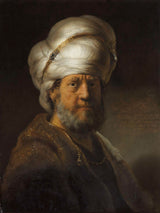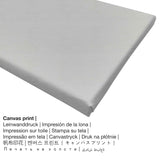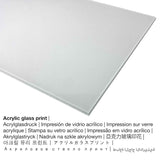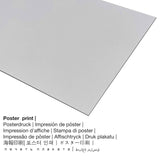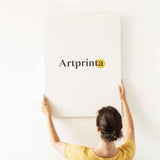Rembrandt van Rijn, 1635 - Nwoke na ejiji Oriental - mbipụta nka mara mma
Ụtụ gụnyere. Mbupu gbakọrọ na ndenye ọpụpụ.
Nkọwa ngwaahịa nka
Ọrụ nka nke narị afọ nke 17 a Man in Oriental Dress e sere ya nwoke Dutch onye na-ese ihe Rembrandt van Rijn in 1635. Ọ bụ nke mkpokọta nka Rijksmuseum in Amsterdam, Netherlands. Site n'ikike nke: Rijksmuseum (nwere ikike: ngalaba ọha).: . Na mgbakwunye na nke ahụ, nhazi nke mmepụta dijitalụ dị na eserese format ma nwee oke onyonyo nke 3: 4, nke pụtara na ogologo bụ 25% mkpụmkpụ karịa obosara. The painter Rembrandt van Rijn was an artist from the Netherlands, whose art style was mainly Baroque. The painter was born in the year 1606 in Leiden and deceased at the age of 63 na 1669 na Amsterdam.
Họrọ ngwa ngwaahịa gị
The product dropdown menu provides you with the chance to pick your favorite material and size. Choose your favorite size and material between the subsequent preferences:
- Akwụkwọ mmado ebipụtara (akwa akwa akwa): Our poster is a printed canvas with a slightly roughened finish on the surface, that reminds the actual version of the artwork. Please bear in mind, that depending on the absolute size of the poster print we add a white margin of something between 2-6cm round about the artwork, which facilitates the framing with your custom frame.
- Mbipụta kwaaji: The canvas direct print is a printed canvas stretched on a wood frame. It creates a unique impression of three dimensionality. A canvas print of this artwork will allow you to transform your customized fine art print into a large size artpiece like you would see in a gallery. A canvas print has the advantage of being low in weight, meaning that it is easy and straightforward to hang your Canvas print without the support of additional wall-mounts. A canvas print is suited for all kinds of walls.
- Bipụta na iko acrylic na-egbuke egbuke: A glossy acrylic glass print, often named a fine art print on plexiglass, will transform the artwork into brilliant décor and offers a great alternative to canvas and aluminidum dibond prints. With an acrylic glass art print sharp contrasts and granular artwork details will be visible because of the fine tonal gradation.
- Aluminom dibond (ọkpụkpụ ọla): This is a metal print made on aluminium dibond material with an impressive depth effect. The non-reflective surface structure creates a contemporary impression. The Aluminium Dibond Print is your excellent introduction to the sophisticated world of reproductions with aluminum. The bright parts of the work of art shimmer with a silky gloss but without glow.
Nkwupụta iwu: We try everythig possible to describe our art products as accurately as possible and to exhibit them visually. Please bear in mind that the pigments of the print materials, as well as the printing might vary marginally from the representation on the device's monitor. Depending on your screen settings and the condition of the surface, color pigments might not be printed 100% realistically. Bearing in mind that all fine art prints are printed and processed by hand, there may also be minor deviations in the motif's size and exact position.
Banyere akụkọ
| Nkewa ngwaahịa: | nka nka |
| Usoro mmeputakwa: | dijitalụ mmeputakwa |
| Produzọ mmepụta: | Mbipụta UV / dijitalụ |
| Mmalite ngwaahịa: | Germany |
| Stockdị ngwaahịa: | mmepụta ihe na-achọ |
| Ngwaahịa were: | ụlọ mmepụta ihe nka, foto mgbidi |
| Nhazi nke ihe nka: | usoro eserese |
| Oke akụkụ: | 3: 4 |
| Mmetụta akụkụ onyonyo: | ogologo bụ 25% mkpụmkpụ karịa obosara |
| Ụdị ihe dị iche iche dị: | ígwè ebipụta (aluminium dibond), acrylic glass print (nwere ezigbo mkpuchi iko), mbipụta akwụkwọ mmado (akwụkwọ kwaaji), akwụkwọ akwa akwa. |
| Nhọrọ nha nke akwa akwa n'elu etiti ihe na-agbatị (mbipụta kwaaji): | 30x40cm - 12x16", 60x80cm - 24x31", 90x120cm - 35x47", 120x160cm - 47x63" |
| Mbipụta iko acrylic (nke nwere ezigbo mkpuchi iko): | 30x40cm - 12x16", 60x80cm - 24x31", 90x120cm - 35x47", 120x160cm - 47x63" |
| Ụdị akwụkwọ mmado (akwụkwọ kwaaji) dị iche iche: | 30x40cm - 12x16", 60x80cm - 24x31", 90x120cm - 35x47" |
| Aluminom dibond ọdịdị nha ebipụta: | 30x40cm - 12x16", 60x80cm - 24x31", 90x120cm - 35x47" |
| Igwe onyonyo: | oyiri nka na-enweghị isi |
Nkọwa gbasara akụkụ nka mbụ
| Aha ọrụ nka: | "Man in Oriental Dress" |
| Nhazi nka: | sere |
| Okwu nche anwụ: | nka ochie |
| Nhazi oge: | 17th narị afọ |
| Afọ nka: | 1635 |
| Afọ nka: | ihe karịrị afọ 380 |
| Ụlọ ihe ngosi nka / ebe: | Rijksmuseum |
| Ebe ngosi nka: | Amsterdam, Netherlands |
| Ibe weebụ: | Rijksmuseum |
| License: | ngalaba ọha |
| Site n'aka: | Rijksmuseum |
Tebụl nkọwa omenkà
| Aha onye nka: | Rembrandt van Rijn |
| okike onye nka: | nwoke |
| Obodo onye nka: | Dutch |
| Ọrụ onye na-ese ihe: | onye na-ese ihe |
| Mba onye si: | mba netherland |
| nhazi ọkwa: | nna ukwu ochie |
| Ụdị nke onye na-ese ihe: | Baroque |
| Nwụrụ na afọ nke: | 63 afọ |
| Afọ ọmụmụ: | 1606 |
| Ebe amụrụ onye: | Leiden |
| Nwụrụ n'afọ: | 1669 |
| Ebe ọnwụ: | Amsterdam |
© nwebisiinka, Artprinta (www.artprinta.com)
Kedu ihe Rijksmuseum state about this 17th century artwork painted by Rembrandt van Rijn? (© - site na Rijksmuseum - Rijksmuseum)
Rembrandt manipulated light in a highly personal way. Here, the man’s turban and the right side of his face are brilliantly illuminated, while the left side is in shadow. Exotic character heads like this – they are not portraits – were extremely popular in the 17th century; early on, they were widely copied and imitated. They were known as ‘Turkish tronies’.

